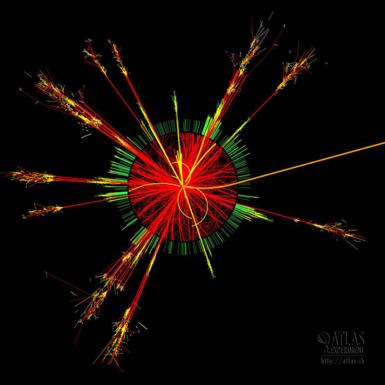You are hereBlogs / WcP.Scientific.Mind's blog / Large Hadron Collider hibernates after wrong sort of big bang caused by hellion leak, to re-awaken in Spring'09
Large Hadron Collider hibernates after wrong sort of big bang caused by hellion leak, to re-awaken in Spring'09

(quote)
Two weeks ago, the most powerful atom smasher to be built had been switched on to global acclaim and scientists were ready to begin experiments that could unlock many of the enduring mysteries of the Universe. They are going to have to wait a little longer. On Friday the Large Hadron Collider (LHC) created the wrong sort of big bang - a fault so serious that CERN, the European Organization for Nuclear Research, announced last night that the particle accelerator would have to be shut down until next spring for repairs.

Preliminary investigations into the incident, in which a huge quantity of helium leaked from the LHC’s cooling system, have suggested that it was caused by a faulty electrical connection between two of its superconducting magnets. The fault affected a part of the accelerator that is kept chilled to within 1.9C of absolute zero, and it will have to be warmed up to room temperature before the problem can be understood fully and resolved. It will take at least three to four weeks to warm the affected sector and then to open the damaged magnets for inspection, and then another month to re-chill them to their operating temperature.

Even then, engineers will not be able to switch the LHC back on. The accelerator was always scheduled to be turned off for winter maintenance in December, and CERN officials confirmed last night that this was “obligatory” and would not be postponed. No more beams of protons will be traveling around the collider’s 17-mile (27km) ring until early spring, and it will then be several weeks before it can start smashing them together to re-create the conditions of the big bang. Operations are likely to restart in late March or early April. The LHC’s official inauguration on October 21, which President Sarkozy of France is expected to attend, will still go ahead as scheduled.

Friday’s incident was what is known as a quench, in which the operating temperature of some of the magnets that bend and accelerate the particle beams began to rise. The fire brigade was called, and it soon emerged that as much as a tonne of helium had escaped from the cooling system that chills the magnets of sector 3-4 of the LHC ring. Some of the magnets rose in temperature by as much as 100C. It immediately became clear that the LHC would not be able to begin trial particle collisions this week, as had been planned, to start calibrating the accelerator’s vast detectors that will look for new physical phenomena. The full extent of the damage began to emerge over the weekend, when CERN announced that a two-month shutdown would be required. It then became clear that there would be little point trying to start it up again before the winter maintenance break, which is necessary for safety reasons.

The LHC’s network of magnets, which will eventually fire protons at 99.9999991 per cent of the speed of light, are chilled to 1.9C above absolute zero so that current flows through their coils without resistance. This superconductivity allows the magnets to generate much stronger fields than would otherwise be possible. A quench occurs when these magnets warm up and lose their superconducting properties. The online logbook described the incident as a “massive quench”.
Physicists from other atom smashers offered their sympathy. Peter Limon, who led the commissioning team for the US Tevatron accelerator, said: “The LHC is a very complex instrument, huge in scale and pushing technological limits in many areas. Events occur from time to time that temporarily stop operations.”
(unquote)
Photos courtesy of AFP/CMS, CERN Geneva/PA, Reuters/Fabrice Coffrini/Pool
Original Source: Times Online UK
Photo Gallery: Pictures: Large Hadron Collider
Related Article: LHC Won’t Be Back Online Until Spring of 2009


















